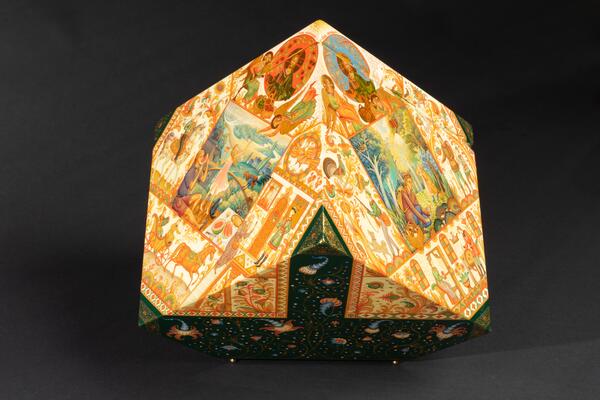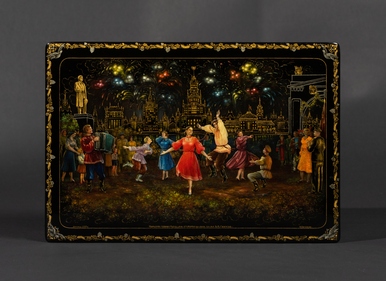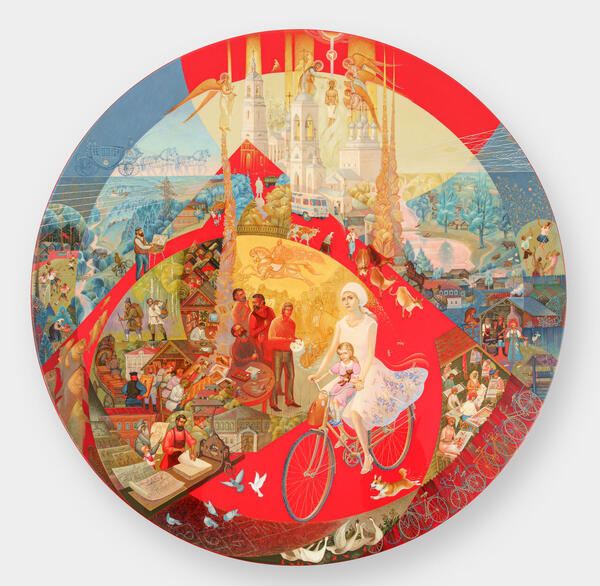The Molodkin dynasty holds an important place in modern Mstyora lacquer painting. The head of the dynasty, Vladimir Nikolaevich, is an Honored Artist of Russia. He raised three sons who followed in his footsteps.
This chest was painted by Denis Molodkin. The museum displays several works of the artist and his brother Nikolai. They both have developed their own unique artistic styles.
The miniatures created by Denis are easily recognizable by elaborate multi-figure compositions. In his works, the artist combined traditional local technique of painting with tempera (paints mixed with egg yolk) and a peculiar interpretation of imagery.
The chest ‘Russian Province’ is one of the experimental works of the master. He decided to paint on an unusual chest in the shape of a truncated cube. On its three sides, the artist depicted scenes inspired by three Orthodox summer holidays — Honey, Apple and Nut Feasts of the Savior. The master organically incorporated ordinary everyday scenes with religious imagery.
Denis Molodkin depicted a composition dedicated to the Honey Feast of the Savior on the lid of the chest. In the center, one could see an idyllic scene of fishing on a pond with reeds and water lilies. A mischievous cat, who is trying to catch a fish, arrests the viewer’s attention.
The master framed the central composition with scenes from rural and urban life (such composition echoes “kleima” on icons — additional border scenes in rectangular panels). They are painted in a stylized decorative manner. Christ Pantocrator and Angels collecting honey are portrayed at the top of the chest. The scenes are distinguished by sophisticated ornaments and vivid color schemes.
The images on the other two sides are constructed on the same principle. One composition — the scene of eating a watermelon — is dedicated to the Apple Feast of the Savior; the other — the scene of picking mushrooms in the forest — to the Nut Feasts of the Savior.
Denis Molodkin gained a reputation not only as a master of lacquer miniature painting on papier mâché items; he also engages in graphics and icon painting. The themes of his works are diverse: the artist turns to folklore, literary and religious subjects, works with genre scenes (portrayals of ordinary people and events).
This chest was painted by Denis Molodkin. The museum displays several works of the artist and his brother Nikolai. They both have developed their own unique artistic styles.
The miniatures created by Denis are easily recognizable by elaborate multi-figure compositions. In his works, the artist combined traditional local technique of painting with tempera (paints mixed with egg yolk) and a peculiar interpretation of imagery.
The chest ‘Russian Province’ is one of the experimental works of the master. He decided to paint on an unusual chest in the shape of a truncated cube. On its three sides, the artist depicted scenes inspired by three Orthodox summer holidays — Honey, Apple and Nut Feasts of the Savior. The master organically incorporated ordinary everyday scenes with religious imagery.
Denis Molodkin depicted a composition dedicated to the Honey Feast of the Savior on the lid of the chest. In the center, one could see an idyllic scene of fishing on a pond with reeds and water lilies. A mischievous cat, who is trying to catch a fish, arrests the viewer’s attention.
The master framed the central composition with scenes from rural and urban life (such composition echoes “kleima” on icons — additional border scenes in rectangular panels). They are painted in a stylized decorative manner. Christ Pantocrator and Angels collecting honey are portrayed at the top of the chest. The scenes are distinguished by sophisticated ornaments and vivid color schemes.
The images on the other two sides are constructed on the same principle. One composition — the scene of eating a watermelon — is dedicated to the Apple Feast of the Savior; the other — the scene of picking mushrooms in the forest — to the Nut Feasts of the Savior.
Denis Molodkin gained a reputation not only as a master of lacquer miniature painting on papier mâché items; he also engages in graphics and icon painting. The themes of his works are diverse: the artist turns to folklore, literary and religious subjects, works with genre scenes (portrayals of ordinary people and events).




